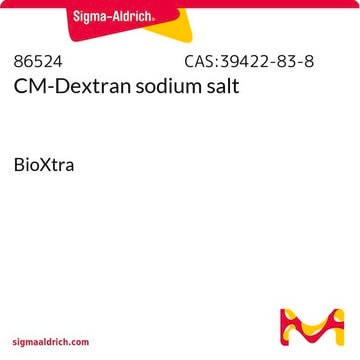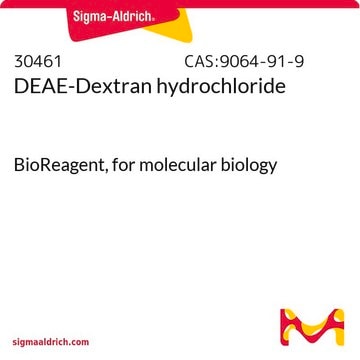Recommended Products
conjugate
biotin conjugate
form
powder
mol wt
10,000
extent of labeling
~2 mol per mol
color
white
solubility
H2O: soluble 50 mg/mL, clear, colorless to faintly yellow
storage temp.
2-8°C
Looking for similar products? Visit Product Comparison Guide
Application
Biotin-dextran is used in tissue staining to prepare neurons for detection by avidin-conjugated detection systems. It is taken up by neuronal processes and transported bi-directionally. It infiltrates axon boutons in the anterograde direction and dendritic processes in the retrograde direction. Staining can be observed in fixed and sectioned tissue from two days to two weeks after biotin-dextran is injected into the brain or spinal cord. It can also be applied to cut nerve tracts. Biotinylated neurons are detected by either light or electron microscopy following incubation with avidin-horseradish peroxidase conjugate and the electron-dense substrate 3,3′-diaminobenzidine (DAB).
Other Notes
To gain a comprehensive understanding of our extensive range of Dextrans for your research, we encourage you to visit our Carbohydrates Category page.
Storage Class Code
11 - Combustible Solids
WGK
WGK 3
Flash Point(F)
Not applicable
Flash Point(C)
Not applicable
Personal Protective Equipment
dust mask type N95 (US), Eyeshields, Gloves
Certificates of Analysis (COA)
Search for Certificates of Analysis (COA) by entering the products Lot/Batch Number. Lot and Batch Numbers can be found on a product’s label following the words ‘Lot’ or ‘Batch’.
Already Own This Product?
Find documentation for the products that you have recently purchased in the Document Library.
Customers Also Viewed
Prefrontal cortical inputs to the basal amygdala undergo pruning during late adolescence in the rat.
Victoria L Cressman et al.
The Journal of comparative neurology, 518(14), 2693-2709 (2010-05-28)
Transformations in affective and social behaviors, many of which involve amygdalar circuits, are hallmarks of adolescence in many mammalian species. In this study, using the rat as a model, we provide the first evidence that afferents of the basal amygdala
Bao-Ling Du et al.
Brain research, 1400, 87-98 (2011-06-11)
Delivery of cellular and/or trophic factors to the site of injury may promote neural repair or axonal regeneration and return of function after spinal cord injury. Engineered scaffolds provide a platform to deliver therapeutic cells and neurotrophic molecules. To explore
Shih-Yen Tsai et al.
Stroke, 42(1), 186-190 (2010-11-23)
we have shown that anti-Nogo-A immunotherapy to neutralize the neurite growth inhibitory protein Nogo-A results in functional improvement and enhanced plasticity after ischemic stroke in the adult rat. The present study investigated whether functional improvement and neuronal plasticity can be
Yang-Can Duan et al.
Pflugers Archiv : European journal of physiology, 459(1), 1-9 (2009-07-25)
This study is to determine whether the nucleus of solitary tract (NTS) is an important component of the central neurocircuitry of the cardiac sympathetic afferent reflex (CSAR) and whether the gamma-aminobutyric acid (GABA) in the NTS modulates the CSAR. Renal
Jia Liu et al.
Journal of the neurological sciences, 325(1-2), 127-136 (2013-01-16)
The stem cell-based experimental therapies are partially successful for the recovery of spinal cord injury (SCI). Recently, acellular spinal cord (ASC) scaffolds which mimic native extracellular matrix (ECM) have been successfully prepared. This study aimed at investigating whether the spinal
Our team of scientists has experience in all areas of research including Life Science, Material Science, Chemical Synthesis, Chromatography, Analytical and many others.
Contact Technical Service










